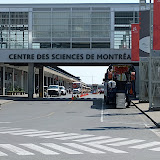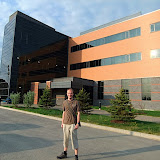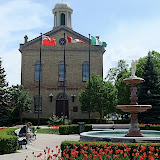It can only be described as an honour to be shown around a world class science centre, and I have to say that I really have been spoilt having this as my first visit. In fact, my tour will be bookended by what are seen to be the best centres on the continent - the Ontario Science Centre (OSC) in Toronto and San Francisco's Exploratorium in September. The photos from my visit can be found by clicking the link below.
Basics
The OSC was built for Canada's centennial, opening two years later in 1969, since which time 44 million people have gone through its doors. It was designed to be three seperate buildings linked by bridges and escalators going down into the ravine created by the Don River, giving the feel of going deeper into the engagement of science. This cascade effect works very well, especially when you add that the linking tunnels have open glass walls allowing you to engage with the nature outside the centre as well as the science within.
Experience
One of the problems facing science centres across the world is the internet; why spend your free time and hard-earned money visiting a science centre when you can find out the learning online for free? This was the first question answered by my host,
Sara Poirier, who is a researcher and programmer in astronomy and space sciences and has a sparkling history in science engagement. They have been using all the tools at their disposal to innovate and come up with ways to create a Next Generation Science Centre, offering an experience unlike anything online.
It is quite surprising to see people walking around in lab coats, but in goes to exemplify what the OSC does with potential problems - it takes them, turns them around and uses them to its advantage. The public is given a fear of 'science', both by the media and through the generations and so the lab coat can be seen by some to be a barrier, a symbol of that inaccessibility. It is, however what is inside the lab coats that matters. Here are no dusty, old researchers that only talk in jargon, these are young, enthusiastic communicators who engage, enthuse and demonstratively love their jobs.
The staff, I must say, are the OSC's finest asset. All of them are fun, friendly and engaging, and the first three I met on the bottom level were artists. You may wonder why science graduates aren't being insisted upon here - I can answer that from my university days. I was lectured by some of the greatest minds in the country at Cambridge, but they couldn't teach at all. They were trained too much in academia rather than communication. One guy I met was a theatre major and he has been given the opportunity to create theatrical pieces with another colleague for putting on in the centre. Another is an opera singer, and so on. The point is that the Centre is employing people who are naturally communicative and giving them the science; they aren't just taking scientists and hoping they'll learn 'people skills'.
What's more is that the staff are not left in one place to do one thing. All staff are on rotation, from presenting in the planetarium to being on the floors to enrich the visitors' experience. Here again the innovation aspect comes into play; as you enter the Weston Family Innovation Centre (WFIC) you are greeted by a small stage with seats encircling it - the HotSpot. At various times throughout the day a presenter will come along and spend 10-15 minutes talking through the issues of the day. These are found earlier by looking through journals and chosen by the presenters themselves. Here is cutting edge science being explained by the people who are interested in it, and this later goes into the podcast.
The WFIC is a dynamic public interaction space, designed for youth and filled with breathtaking risky collaborative works. The scope is awesome, the interactives very innovative. Where else can you get your face created in tubes of bubbles running from floor to ceiling? What about a cylinder of iron filings suspended in oil which can be magnetised by visitors playing a piano - or, more significantly, plugging in their MP3 player? What is most important though is that all staff from across the building, not just one space, are brought together to brainstorm ideas for this area. We need an interactive to do xyz, let's take some risks and see what we come up with.
This audacity and collaboration takes place within the Challenge Zone, where school and public parties are also given the opportunity to explore real-world situations. A group may be asked, say, to design a flood defense mechanism that is waterproof, windproof, quickly assembled and can fold away easily. They then go off, design their ideas on paper, take them for approval by the quartermaster and then build them from the materials provided. What I appreciated was that this creative process was shared by all staff for the interactives, both online and offline, and that gives a really collaborative feel to the whole building.
Of course, the web is playing a huge part in every museum and public space and like others, the OSC has the opportunity for visitors to make things in the centre and access them online, whether it be results or their stop-motion videos. One story that I was told is that someone brought in a chess set and did a 10 minute stop-motion animation of a game. There is also the feel of the public leaving their mark, with plenty of interactives asking for ideas and opinions - visitors contribute data, which shapes the future experience.
Engagement
Science purists may well be grumbling that I make so much of hiring actors to be the gallery staff and letting them run free to integrate the two disciplines. Another major aspect of the OSC is that scientists are brought in to do research in-house, on the proviso that they give a series of talks to the public during the day. The WFIC hosted a group of scientists researching youth issues with privacy on facebook, on the back of concerns that social media and networking from the centre could have negative effects. Here again the OSC takes a problem and collaborates to investigate it and turns it into engaging science. Another group came in from the Sick Kids hospital to investigate and explain genes and their actions.
The scientists aren't just in-house, however. The OSC partners with local schools and universities to showcase work via flickr and the galleries. A group from York University looking at solar panels came in to design a challenge for the WFIC's Challenge Zone and then could engage with the visitors who turned up. The centre also now host the annual Youth Innovation Award, which has just announced its second winner, who designed a way to refine methane from rural sources and make it usable as fuel.
The engagement is not just for youth and adults - toddlers are allowed an incredible experience in the Kidspark, and the OSC has brought students in from local universities to help show parents where their children are learning from the interactives. Here the whole family is included and shown where the educational growth is happening. This is also evident in the planetarium's new toddler show, which is just as much for the parents' involvement as the childrens'.
Space
Of course, my particular interest is in the astronomy and space areas where Sara and her team have done a marvellous job. The 50-seater planetarium has a Sky-scan twin Zeiss projector and a unique way of seating its 'crew'. At the front of the very intimate space are beanbags for those who want them, or there are benches at the back. The presenter for my show was Rochelle, who communicated the material personably, enthusiastically and with a lot of science, though this was not in any way off-putting. There was a good response from the audience, and justifiably so. There was a mix of real-time night-sky and presenter-led video, and each show as a result is different, because every presenter is different and can tailor their presentation to the audience they have.
Outside in the space section, the fusion of art and science creates a wonderful experience without skimping on any of the detail. Displayed is a quote by Einstein:
The most beautiful thing we can experience is the mysterious. It is the source of all true art and all science.
The meteorites are displayed in the style of a jewellery exhibition, like 'Tiffany's meets Superman's cave'. A piece of Moon Rock and one of Mars Rock sit in adjacent panels which the answers to their FAQ's for all to read.
With all my talk of innovation and new things, the OSC hasn't forgotten its older exhibits. The old planetarium projector is a beautiful old Zeiss analogue piece, but instead of junking it, they have enshrined and labelled it so that it provides a great conversation opener for visitors. The interactive that sticks most in my mind is a gravitational flyby simulator where a ball bearing is rolled down a ramp to a spinning disc, under on side of which is a powerful magnet, simulating a spacecraft being tugged by a planet. If you get the timing right the ball gets hurled to a bell at the end of the box; if not, oblivion awaits. It's an old piece that's been around for years, but it has been renewed and updated to show the ball as Cassini and the disc now shows Venus in orbit around the Sun; the waiting bell is Saturn. A lovely touch, rooted in recent science.
Others
What is great about the OSC is it doesn't seek to lecture you, merely to inform and invite you to play and question. The Question of Truth section talks about scientific bias and what role that plays in our definitions of the world. I felt this particularly apt, because it brought home the fact that although science seeks to find what is objectively true, it can only create a model of the world which is interpreted by our human eyes.
All around the centre, the interactives are well-signed with plenty of information for those who want to read it and short descriptions for those who do not. The balance is pitched perfectly and innovatively. There is even a small rainforest for exploration, and a drinking water taste test, where you can try different waters and vote for which one tastes best. An innovative way to keep visitors hydrated.
Science was, as I said earlier, everywhere. In the toilets I was confronted with a poster saying that men don't wash their hands as much as women and challenging me to redress that balance. It showed me also which areas are most frequently missed when washing, which I thought an amazing bit of engagement. The OSC is full of nice little touches like that, from the two very friendly gentlemen in the Amateur Radio booth to the transparent elevators and escalators which allow you to see the machinery within.
Online
The main OSC website (www.ontariosciencecentre.ca) is clear, informative and gives visitors the opportunity to take a virtual tour before their arrival. Special mention however must go to Redshift Now (www.redshiftnow.ca), which strives to be the science content portal for the centre, combining the elements of innovation with the research and engagement of the scientists who work there. Ken Huxley is the man behind this and he also presents the Redshift Report podcasts which you can find from that site or via all good podcast catchers.
Summary
I think it's fair to say that the OSC has a wonderfully unique way of engaging the public with the science that's in the world around them. I'd certainly love to work there, and that was evident on the faces of all the staff I met whilst I was there. It combines creativity, encourages personal development and really shows what can be achieved when staff are given the freedom to create and play. The fusion of science and wonder is perfect, the pitching level spot on. My only gripe is that it could be better served by public transport, but that's really nothing at all on the scale of how much of a world leader this place is.
Special thanks once again must go to Sara, Ken, Tyler, John, Rochelle, Heidi, Walter and everyone else whom I met there. I had an incredible time and left buzzing with ideas and potential. That is the mark of a great science centre, and all credit to you.









